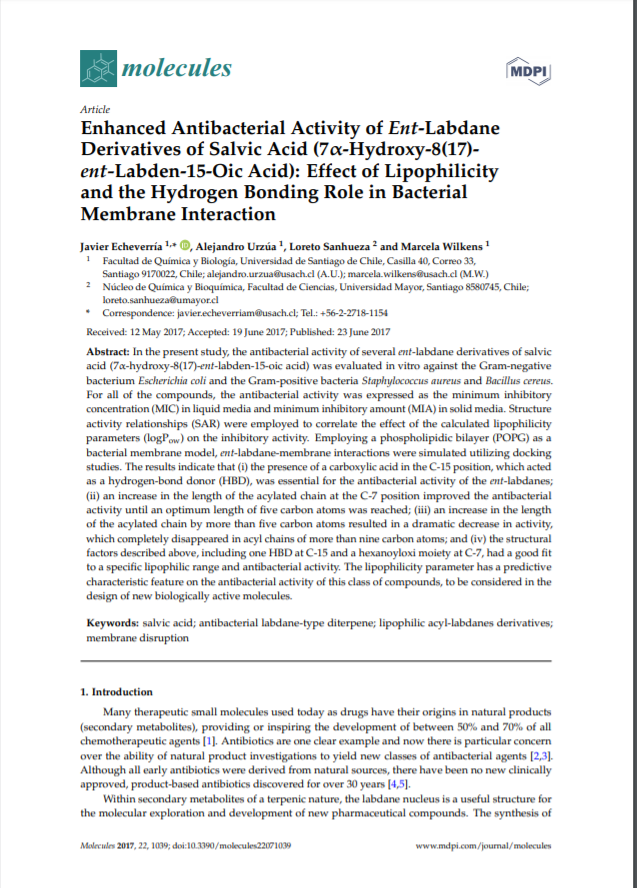Enhanced antibacterial activity of Ent-Labdane derivatives of Salvic acid (7α-Hydroxy-8(17)-ent-Labden-15-Oic acid): Effect of Lipophilicity and the Hydrogen Bonding Role in Bacterial Membrane Interaction

Fecha
2017Autor
Echeverría J., Urzúa A., Wilkens M.
Sanhueza, L. [Núcleo de Química y Bioquímica, Facultad de Ciencias, Universidad Mayor, Chile]
Ubicación geográfica
Notas
HERRAMIENTAS
Acceda a títulos restringidos
¿Cómo descargar?Resumen
In the present study, the antibacterial activity of several ent-labdane derivatives of salvic acid (7α-hydroxy-8(17)-ent-labden-15-oic acid) was evaluated in vitro against the Gram-negative bacterium Escherichia coli and the Gram-positive bacteria Staphylococcus aureus and Bacillus cereus. For all of the compounds, the antibacterial activity was expressed as the minimum inhibitory concentration (MIC) in liquid media and minimum inhibitory amount (MIA) in solid media. Structure activity relationships (SAR) were employed to correlate the effect of the calculated lipophilicity parameters (logPow) on the inhibitory activity. Employing a phospholipidic bilayer (POPG) as a bacterial membrane model, ent-labdane-membrane interactions were simulated utilizing docking studies. The results indicate that (i) the presence of a carboxylic acid in the C-15 position, which acted as a hydrogen-bond donor (HBD), was essential for the antibacterial activity of the ent-labdanes; (ii) an increase in the length of the acylated chain at the C-7 position improved the antibacterial activity until an optimum length of five carbon atoms was reached; (iii) an increase in the length of the acylated chain by more than five carbon atoms resulted in a dramatic decrease in activity, which completely disappeared in acyl chains of more than nine carbon atoms; and (iv) the structural factors described above, including one HBD at C-15 and a hexanoyloxi moiety at C-7, had a good fit to a specific lipophilic range and antibacterial activity. The lipophilicity parameter has a predictive characteristic feature on the antibacterial activity of this class of compounds, to be considered in the design of new biologically active molecules.
URI
https://www.mdpi.com/1420-3049/22/7/1039https://www.ncbi.nlm.nih.gov/pmc/articles/PMC6152121/pdf/molecules-22-01039.pdf
https://doi.org/10.3390/molecules22071039
http://repositorio.umayor.cl/xmlui/handle/sibum/6958
Coleccion/es a la/s que pertenece:
Si usted es autor(a) de este documento y NO desea que su publicación tenga acceso público en este repositorio, por favor complete el formulario aquí.